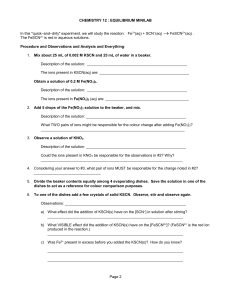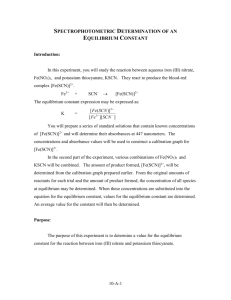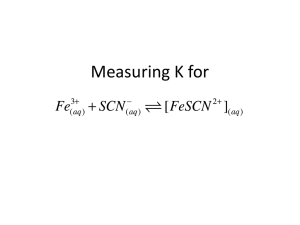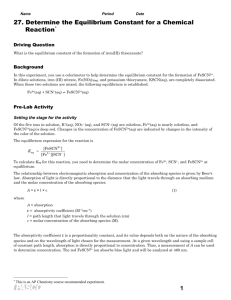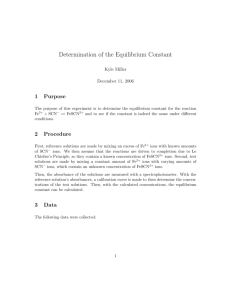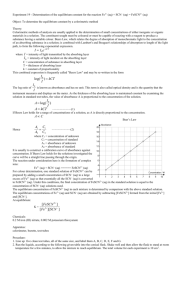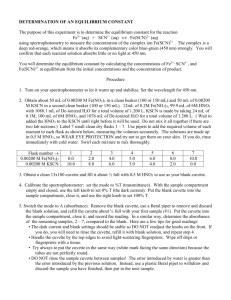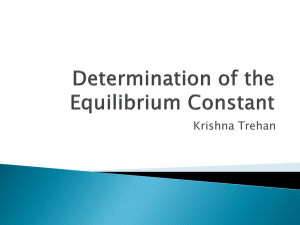PRINCIPLES OF EQUILIBRIUM Experiment 12H (Parts A and B)
advertisement
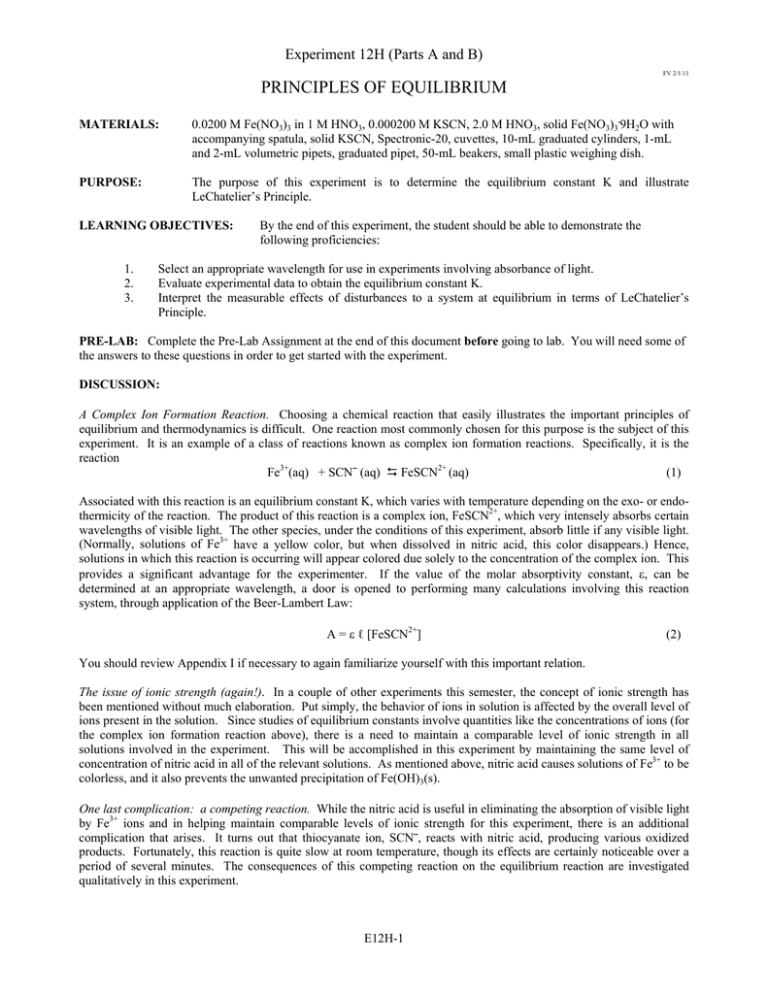
Experiment 12H (Parts A and B) FV 2/1/11 PRINCIPLES OF EQUILIBRIUM MATERIALS: 0.0200 M Fe(NO3)3 in 1 M HNO3, 0.000200 M KSCN, 2.0 M HNO3, solid Fe(NO3)3.9H2O with accompanying spatula, solid KSCN, Spectronic-20, cuvettes, 10-mL graduated cylinders, 1-mL and 2-mL volumetric pipets, graduated pipet, 50-mL beakers, small plastic weighing dish. PURPOSE: The purpose of this experiment is to determine the equilibrium constant K and illustrate LeChatelier’s Principle. LEARNING OBJECTIVES: 1. 2. 3. By the end of this experiment, the student should be able to demonstrate the following proficiencies: Select an appropriate wavelength for use in experiments involving absorbance of light. Evaluate experimental data to obtain the equilibrium constant K. Interpret the measurable effects of disturbances to a system at equilibrium in terms of LeChatelier’s Principle. PRE-LAB: Complete the Pre-Lab Assignment at the end of this document before going to lab. You will need some of the answers to these questions in order to get started with the experiment. DISCUSSION: A Complex Ion Formation Reaction. Choosing a chemical reaction that easily illustrates the important principles of equilibrium and thermodynamics is difficult. One reaction most commonly chosen for this purpose is the subject of this experiment. It is an example of a class of reactions known as complex ion formation reactions. Specifically, it is the reaction Fe3+(aq) + SCN¯ (aq) FeSCN2+ (aq) (1) Associated with this reaction is an equilibrium constant K, which varies with temperature depending on the exo- or endothermicity of the reaction. The product of this reaction is a complex ion, FeSCN2+, which very intensely absorbs certain wavelengths of visible light. The other species, under the conditions of this experiment, absorb little if any visible light. (Normally, solutions of Fe3+ have a yellow color, but when dissolved in nitric acid, this color disappears.) Hence, solutions in which this reaction is occurring will appear colored due solely to the concentration of the complex ion. This provides a significant advantage for the experimenter. If the value of the molar absorptivity constant, , can be determined at an appropriate wavelength, a door is opened to performing many calculations involving this reaction system, through application of the Beer-Lambert Law: A = ℓ [FeSCN2+] (2) You should review Appendix I if necessary to again familiarize yourself with this important relation. The issue of ionic strength (again!). In a couple of other experiments this semester, the concept of ionic strength has been mentioned without much elaboration. Put simply, the behavior of ions in solution is affected by the overall level of ions present in the solution. Since studies of equilibrium constants involve quantities like the concentrations of ions (for the complex ion formation reaction above), there is a need to maintain a comparable level of ionic strength in all solutions involved in the experiment. This will be accomplished in this experiment by maintaining the same level of concentration of nitric acid in all of the relevant solutions. As mentioned above, nitric acid causes solutions of Fe3+ to be colorless, and it also prevents the unwanted precipitation of Fe(OH)3(s). One last complication: a competing reaction. While the nitric acid is useful in eliminating the absorption of visible light by Fe3+ ions and in helping maintain comparable levels of ionic strength for this experiment, there is an additional complication that arises. It turns out that thiocyanate ion, SCN‾, reacts with nitric acid, producing various oxidized products. Fortunately, this reaction is quite slow at room temperature, though its effects are certainly noticeable over a period of several minutes. The consequences of this competing reaction on the equilibrium reaction are investigated qualitatively in this experiment. E12H-1 PROCEDURE: Part A. Determining the Molar Absorptivity of FeSCN2+ 1. The absorbance spectrum of a solution containing FeSCN2+ ions was provided in the Pre-Lab Exercises. Solutions of the other two species involved in the complex ion formation reaction are in the laboratory. Based on your Pre-Lab work and observation of these solutions, determine an appropriate wavelength for use in this equilibrium study. Set the filter and wavelength on the Spectronic 20 instrument to the appropriate values. 2. Use pipets to add 2.00 mL each of 2.0 M HNO3 and 0.000200 M KSCN solutions to a clean, dry cuvette. Agitate the tube to mix well. First, use this solution as a blank while calibrating the Spectronic-20 at the selected wavelength. 3. Obtain about 0.6 g of solid Fe(NO3)3.9H2O. Add this material to the solution in the cuvette and mix until the granules are completely dissolved. Measure and record the absorbance. Discard this solution in the sink, flushing with water. Complete Part A of the worksheet. Part B. More Examples of LeChatelier’s Principle 1. Answer the worksheet questions for Part B, step 1. 2. Prepare a new reaction mixture that will have the same total volume as the last run, but now with different amounts of the two reactants. To a clean, dry cuvette, add 2.00 mL of 0.0200 M Fe3+ solution (dissolved in 1 M HNO3), 3.00 mL of 0.000200 M KSCN, 2.00 mL of water and 1.00 mL of 2.0 M nitric acid, and measure the absorbance. Answer the worksheet questions for Part B, step 3. 4. Prepare a reaction mixture that will allow you to double the volume of the solution in step 1 while maintaining a constant ionic strength, i.e., constant HNO3 concentration. As in step 1, add 2.00 mL of 0.0200 M Fe3+ solution (dissolved in 1 M HNO3) and 2.00 mL of 0.000200 M KSCN to a clean, dry cuvette. Then add 3.00 mL of water and 1.00 mL of 2.0 M nitric acid to the cuvette. The additional nitric acid maintains the ionic strength of the solution at a constant value. Measure the absorbance to verify (or not) your prediction from the Pre-Lab exercises. Answer the worksheet questions for Part B, step 2. 3. To a clean, dry cuvette, add 2.00 mL of 0.0200 M Fe3+ solution (dissolved in 1 M HNO3) and 2.00 mL of 0.000200 M KSCN. After mixing well, measure and record the absorbance. With the last solution still in the Spec 20 instrument, drop a few crystals of solid KSCN into the cuvette and note any changes to the %T or absorbance. Then, check your prediction about the effect of the loss of SCN‾ by reaction with HNO3 by leaving the solution in the spectrophotometer for a few minutes, observing the reading. How did the observations compare to your predictions? Answer the worksheet questions for Part B, step 3. Clean-Up: 1. Discard all solutions down the drain with running water. 2. Clean all glassware and pick up all paper litter. E12H-2 QUESTIONS 1. Suppose a solution could be made with the following ionic species concentrations at 25oC: [Fe3+] = 0.0015 M, [SCN‾] = 0.0010 M, and [FeSCN2+] = 0.00080 M. Using the results of your experiment, determine whether this system is at equilibrium or, if not, in which direction the reaction would spontaneously proceed. Would the intensity of the color of the solution increase or decrease as equilibrium was approached? 2. A water sample is to be tested for the presence of Fe3+ ions. To 10.0 mL of water is added some nitric acid and a high concentration of SCN‾, resulting in a new total volume of 15.0 mL. The solution becomes slightly red in color. The %T at the wavelength used in this experiment was found to be 85.6%. From this information, and using your experimentally determined molar absorptivity , determine the molarity and ppm of Fe3+ in the sample. OPTIONAL QUESTIONS (Instructor’s choice): 1. While adding the solid Fe(NO3)3.9H2O, the volume of the solution increased slightly, though this was ignored in the calculation. What does this indicate about the calculated value of the molar absorptivity? Explain. 2. Explain how the reaction of the SCN‾ with nitric acid, discussed in Part B, step 4, affects the results of this experiment, and whether these effects are significant or not. 3. For an endothermic reaction where only one of the reactants absorbs visible light, explain whether a solution in which this reaction is at equilibrium will fade or intensify as the temperature increases. 4. Determine the concentration of the complex ion FeSCN2+ in the solution at the end of Part A, step 3 of the procedure, i.e., after all 0.6 g of the iron nitrate compound have been dissolved in the solution. Use the value of K at 298.15K determined in the other calculations, and assume no volume change in the solution while adding the solid iron nitrate compound. How does this concentration compare with the concentration you assumed for determining the value of the molar absorptivity constant ? E12H-3 EXP. 12H WORKSHEET – PARTS A & B Name ________________________________________ Please carry 3 significant figures in all calculations! Reaction: Fe (aq) + SCN¯ (aq) ⇌ FeSCN2+ (aq) 3+ Part A. Determining the Molar Absorptivity of FeSCN2+ Part A mixture: 2.00 mL 2.0 M HNO3 2.00 mL 0.000200 M KSCN 0.6 g Fe(NO3)3·9H2O Absorbance = _________________ MIX THOROUGHLY; dissolve solid i. What is the [FeSCN2+] in the cuvette if the reaction is pushed essentially to completion? [FeSCN2+] = ___________M ii. Use Beer’s Law to find the molar absorptivity, ε, at your chosen wavelength. Include units. ε = ________________ Part B. Determining the Equilibrium Constant Kc Part B, step 1 mixture: 2.00 mL 0.0200 M Fe3+ solution 2.00 mL 0.000200 M KSCN Absorbance = _________________ MIX THOROUGHLY i. Based on the components in the mixture, calculate the initial concentrations of Fe3+ and SCN¯. [Fe3+]i = _________M [SCN¯]i = _________M ii. From Beer’s Law, using your ε value, determine the equilibrium concentration of FeSCN2+. [FeSCN2+]eq = __________M iii. Set up the ICE table and determine the value of the equilibrium constant Kc. Fe3+ (aq) + SCN¯ (aq) ⇌ FeSCN2+ (aq) K = ________ Part B, step 2 mixture: 2.00 mL 0.0200 M Fe3+ solution 2.00 mL 0.000200 M KSCN 1.00 mL 2.0 M HNO3 3.00 mL H2O Absorbance = ____________________ E12H-4 MIX THOROUGHLY i. Based on the components in the mixture, calculate the initial concentrations of Fe3+ and SCN¯. [Fe3+]i = _________M [SCN¯]i = __________M ii. From Beer’s Law, using your ε value, determine the equilibrium concentration of FeSCN2+. [FeSCN2+]eq = ___________M iii. Set up the ICE table and determine the value of the equilibrium constant Kc. Fe3+ (aq) + SCN¯ (aq) ⇌ FeSCN2+ (aq) K = ________ Part B, step 3 mixture: 2.00 mL 0.0200 M Fe3+ solution 3.00 mL 0.000200 M KSCN 1.00 mL 2.0 M HNO3 2.00 mL H2O Absorbance = _________________ MIX THOROUGHLY i. Based on the components in the mixture, calculate the initial concentrations of Fe3+ and SCN¯. [Fe3+]i = ___________ [SCN¯]i = ___________ ii. From Beer’s Law, using your ε value, determine the equilibrium concentration of FeSCN2+. [FeSCN2+]eq = ____________ iii. Set up the ICE table and determine the value of the equilibrium constant Kc. Fe3+ (aq) + SCN¯ (aq) ⇌ FeSCN2+ (aq) K = ________ iv. Compare the K values for these three different Part B mixtures.__________________________________ (Give average and maximum percent deviation from the average.) Part B, step 4: With the last mixture still in the spectrometer sample compartment, record the Absorbance reading. Now add a few crystals of solid KSCN into the cuvette and record the absorbance again. Explain your observations in terms of LeChatelier’s Principle. Original Absorbance ______________ Absorbance after adding KSCN(s) ______________ Explanation: E12H-5 Name __________________________________________ Date __________________ PRE-LAB QUESTIONS Experiment 12H Complete these questions prior to attending lab. Some of the results will be useful in conducting the experiment, so you should record those results in the appropriate section of the lab as well. 1. In Part A, step 1, you are directed to set up the Spectronic 20 instrument for measurement of the FeSCN2+ product ion. Based on the spectra below, what would be an appropriate wavelength for the measurement? Review Appendix I if necessary to again familiarize yourself with the issues related to this decision. Briefly explain your choice. Absorbance spectra for Fe 3+ and FeSCN 2+ Absorbance A 0.5 0.4 0.02 M Fe3+ (dissolved in HNO3) 0.3 0.000048 M FeSCN2+ 0.2 0.1 0 400 500 600 700 wavelength (nm) 2. In Part A, step 3, you will experimentally determine the value of the molar absorptivity, ε, for FeSCN2+ at your selected wavelength. Using the Beer-Lambert law, calculate an approximate value for ε based on the spectrum of 0.000048 M FeSCN2+ provided above. The pathlength, ℓ, for the cuvette is 1.00 cm. 3a. In Part A, step 3, you add about 0.6 g of solid Fe(NO3)3.9H2O to a cuvette containing 2.00 mL of 2.0 M HNO3 and 2.00 mL of 0.000200 M KSCN. Assuming no reaction, what will be the initial molar concentrations of Fe3+ and SCN‾ in the resulting solution? (Don’t forget the dilution effect!) b. Assuming the reaction Fe3+ (aq) + SCN‾ (aq) FeSCN2+ (aq) goes completely to the right, what will be the molar concentration of FeSCN2+ (aq) in the solution resulting from Part A, step 3? (Think about the limiting reactant!) 4a. In Part B, step 2, you will double the volume of an equilibrium solution, and examine the effect. You should be able to predict what will happen when the equilibrium concentrations of all species in the reaction Fe3+(aq) + SCN¯ (aq) FeSCN2+ (aq) are cut in half as the volume is doubled. According to LeChatelier’s Principle, in which direction will the reaction shift as a result of the dilution? b. Will the absorbance of the solution increase or decrease as a result of the dilution? Will the final absorbance reading of the solution be higher or lower than one-half the value that existed before the dilution? Briefly explain your answer. E12H-6
